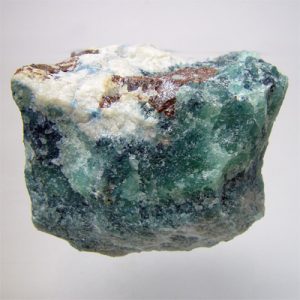Burangaite
Burangaite is a very rare phosphate mineral that is a member of the Dufrénite Group of minerals. It was discovered in 1976 at the Buranga pegmatite, Gatumba District, Western Province, Rwanda and named for this locality. Burangaite is typically blue to blue-green in needle-like crystals and often found associated with Apatite, Bertossaite, Brazilianite, Quartz, Scorzalite, Trolleite, and Wardite. The gem pictured above shows royal blue Burangaite with faintly pinkish to white Bertossaite.
Burangaite was named for the type locality at the Buranga pegmatite, Gatumba District, Western Province, Rwanda.
Burangaite distribution: in the Buranga pegmatite, near Gatumba, Western Province, Rwanda. At Hålsjöberg, Värmland, Sweden. From the Gold Quarry mine, near Carlin, Maggie Creek district, Eureka County, Nevada, USA.
| Chemical Formula: | (NaCa)(Fe2+Mg)Al5(PO4)4(OHO)6 • 2(H2O) |
| Hydrated Sodium Calcium Iron Manganese Phosphate Hydroxide | |
| Molecular Weight: | 738.18 gm |
| Composition: | Sodium | 2.18 % | Na | 2.94 % | Na2O |
| Calcium | 1.63 % | Ca | 2.28 % | CaO | |
| Magnesium | 1.32 % | Mg | 2.18 % | MgO | |
| Aluminum | 18.28 % | Al | 34.53 % | Al2O3 | |
| Iron | 6.05 % | Fe | 6.81 % | FeO / 1.08 % Fe2O3 | |
| Phosphorus | 16.78 % | P | 38.46 % | P2O5 | |
| Hydrogen | 1.31 % | H | 11.71 % | H2O | |
| Oxygen | 52.45 % | O | |||
| 100.00 % | 100.00 % | = TOTAL OXIDE |
| Crystallography: | Monoclinic – Prismatic |
| Crystal Habit: | Crystals are prismatic, bladed, elongated along [010], bounded by {h0l} forms, and complexly terminated by {311} and {223}; may be fibrous. |
| Twinning: | None |
| Cleavage: | Perfect on {100} |
| Fracture: | n/a |
| Tenacity: | Brittle |
| Moh’s Hardness: | 5.0 |
| Density: | 3.05 (g/cm3) |
| Luminescence: | None |
| Radioactivity: | Not Radioactive |
| Color: | Bluish to blue-green; commonly shows a zoned hourglass structure, centrally blue with colorless margins. |
| Transparency: | Semi-transparent |
| Luster: | n/a |
| Refractive Index: | 1.611 – 1.643 Biaxial ( + ) |
| Birefringence: | 0.032 |
| Dispersion: | Relatively strong; r > v |
| Pleochroism: | Strong; X = light blue; Y = dark blue; Z = colorless |


